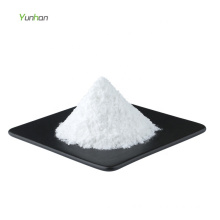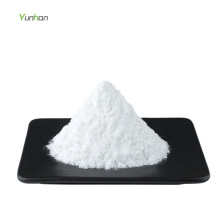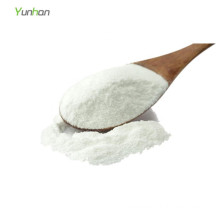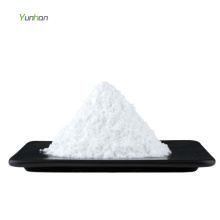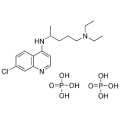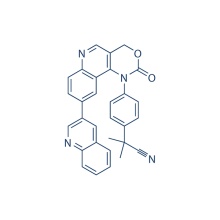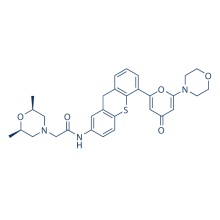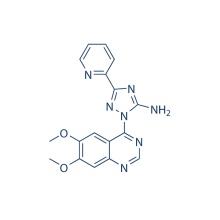Chloroquine Phosphate 50-63-5
Product Description
.cp_wz table {border-top: 1px solid #ccc;border-left:1px solid #ccc; } .cp_wz table td{border-right: 1px solid #ccc; border-bottom: 1px solid #ccc; padding: 5px 0px 0px 5px;} .cp_wz table th {border-right: 1px solid #ccc;border-bottom: 1px solid #ccc; padding: 5px 0px 0px 5px;}
Molecular Weight: 515.86 Chloroquine Phosphate is a 4-aminoquinoline anti-malarial and anti-rheumatoid agent, also acting as an ATM activator.
Chloroquine is a chemotherapeutic agent for the clinical treatment of
malaria. Chloroquine is able to bind to DNA, and inhibit DNA replication
and RNA synthesis which in turn results in cell death. The effect of
Chloroquine may also be related to the formation of a toxic
heme-Chloroquine complex. Chloroquine inhibits trophozoite hemoglobin
degradation through increasing vacuolar pH and inhibiting the activity
of vacuolar phospholipase, vacuolar Proteases, and heme polymerase. Chloroquine possesses definite antirheumatic properties.
Chloroquine
has immuno-modulatory effects, suppressing the production/release of
tumour necrosis factor and interleukin 6. Moreover, Chloroquine exerts
direct antiviral effects, inhibiting pH-dependent steps of the
replication of several viruses including members of the flaviviruses,
retroviruses, and coronaviruses. Its best-studied effects are those
against HIV replication. Chloroquine can accumulate
inside the macrophage phagolysosome by ion trapping where it exerts
potent antifungal activity against Histoplasma capsulatum and Cryptococcus neoformans by distinct mechanisms. Chloroquine inhibits growth of H. capsulatum by pH-dependent iron deprivation, whereas it is directly toxic to C. neoformans.
Conversion of different model animals based on BSA (Value based on data from FDA Draft Guidelines)
For example, to modify the dose of resveratrol used for a mouse (22.4 mg/kg) to a dose based on the BSA for a rat, multiply 22.4 mg/kg by the Km factor for a mouse and then divide by the Km factor for a rat. This calculation results in a rat equivalent dose for resveratrol of 11.2 mg/kg.
Chemical Information
Molarity Calculator
Dilution Calculator
Molecular Weight Calculator
Contact us if you need more details on 50-63-5 Chloroquine Phosphate. We are ready to answer your questions on packaging, logistics, certification or any other aspects about 50-63-5、Chloroquine Phosphate 50-63-5. If these products fail to match your need, please contact us and we would like to provide relevant information.
Molecular Weight: 515.86 Chloroquine Phosphate is a 4-aminoquinoline anti-malarial and anti-rheumatoid agent, also acting as an ATM activator.
Chloroquine is a chemotherapeutic agent for the clinical treatment of
malaria. Chloroquine is able to bind to DNA, and inhibit DNA replication
and RNA synthesis which in turn results in cell death. The effect of
Chloroquine may also be related to the formation of a toxic
heme-Chloroquine complex. Chloroquine inhibits trophozoite hemoglobin
degradation through increasing vacuolar pH and inhibiting the activity
of vacuolar phospholipase, vacuolar Proteases, and heme polymerase. Chloroquine possesses definite antirheumatic properties.
Chloroquine
has immuno-modulatory effects, suppressing the production/release of
tumour necrosis factor and interleukin 6. Moreover, Chloroquine exerts
direct antiviral effects, inhibiting pH-dependent steps of the
replication of several viruses including members of the flaviviruses,
retroviruses, and coronaviruses. Its best-studied effects are those
against HIV replication. Chloroquine can accumulate
inside the macrophage phagolysosome by ion trapping where it exerts
potent antifungal activity against Histoplasma capsulatum and Cryptococcus neoformans by distinct mechanisms. Chloroquine inhibits growth of H. capsulatum by pH-dependent iron deprivation, whereas it is directly toxic to C. neoformans.
Conversion of different model animals based on BSA (Value based on data from FDA Draft Guidelines)
| Species | Baboon | Dog | Monkey | Rabbit | Guinea pig | Rat | Hamster | Mouse |
| Weight (kg) | 12 | 10 | 3 | 1.8 | 0.4 | 0.15 | 0.08 | 0.02 |
| Body Surface Area (m2) | 0.6 | 0.5 | 0.24 | 0.15 | 0.05 | 0.025 | 0.02 | 0.007 |
| Km factor | 20 | 20 | 12 | 12 | 8 | 6 | 5 | 3 |
| Animal A (mg/kg) = Animal B (mg/kg) multiplied by | Animal B Km |
| Animal A Km |
For example, to modify the dose of resveratrol used for a mouse (22.4 mg/kg) to a dose based on the BSA for a rat, multiply 22.4 mg/kg by the Km factor for a mouse and then divide by the Km factor for a rat. This calculation results in a rat equivalent dose for resveratrol of 11.2 mg/kg.
| Rat dose (mg/kg) = mouse dose (22.4 mg/kg) × | mouse Km(3) | = 11.2 mg/kg |
| rat Km(6) |
Chemical Information
| Molecular Weight (MW) | 515.86 |
|---|---|
| Formula | C18H26ClN3.2H3O4P |
| CAS No. | 50-63-5 |
| Storage | 3 years -20℃Powder |
|---|---|
| 6 months-80℃in solvent (DMSO, water, etc.) | |
| Synonyms | |
| Solubility (25°C) * | In vitro | DMSO | <1 mg/mL ( |
|---|---|---|---|
| Water | 100 mg/mL (193.85 mM) | ||
| Ethanol | <1 mg/mL ( | ||
| * <1 mg/ml means slightly soluble or insoluble. * Please note that Selleck tests the solubility of all compounds in-house, and the actual solubility may differ slightly from published values. This is normal and is due to slight batch-to-batch variations. | |||
| Chemical Name | 1,4-Pentanediamine, N4-(7-chloro-4-quinolinyl)-N1,N1-diethyl-, phosphate (1:2) |
|---|
Molarity Calculator
Dilution Calculator
Molecular Weight Calculator
Contact us if you need more details on 50-63-5 Chloroquine Phosphate. We are ready to answer your questions on packaging, logistics, certification or any other aspects about 50-63-5、Chloroquine Phosphate 50-63-5. If these products fail to match your need, please contact us and we would like to provide relevant information.
Product Categories : PI3K/Akt/mTOR > ATM/ATR Inhibitor
Other Products
Hot Products
Astragaloside AChlortetracycline HCl 64-72-2Paclitaxel 33069-62-4Dexamethasone Acetate 1177-87-3Dinaciclib (SCH727965) 779353-01-4CHIR-124 405168-58-3Ro3280 1062243-51-9TAME 901-47-3CCG-1423 285986-88-110058-F4 403811-55-2Dabigatran (BIBR 953) 211914-51-1H 89 2HCl 130964-39-5T0901317 293754-55-9Aprepitant 170729-80-3Turofexorate Isopropyl (XL335) 629664-81-9BMS-378806 357263-13-9

